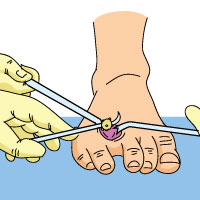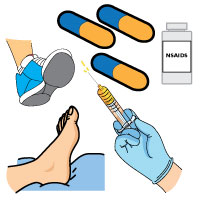What is Morton’s Neuroma Surgery?
Morton’s Neuroma Surgery involves the removal of the neuroma (benign tumor) itself, as well as the affected nerve. In cases where non-surgical treatment for a Morton’s Neuroma is unsuccessful, surgery may be required.
What Should I Expect?
Surgery to remove a Morton’s Neuroma is usually done under general anesthetic, though local anesthetic is also an option. An incision will be made in the top of your foot, between the affected toes. An incision in the top of the foot is preferred as it will interfere less with weight-bearing on the foot after surgery. Once the incision has been made, the neuroma and nerve will be cut out of your foot. Next you will be stitched up and a dressing will be applied to your foot.
Complications
There are risks when it comes to any type of surgical procedure, and Morton’s Neuroma Surgery is no exception. Complications include:
- Allergic reaction to anesthesia
- Infection
- Neuroma reappears
- Toe stiffness
- Deep Vein Thrombosis
Post-Surgery Recovery
Your doctor may recommend that you see a physiotherapist to help you regain proper range of motion after your surgery. Your doctor may also prescribe painkillers to help manage the pain in the weeks following surgery.
You may notice a small amount of blood on your dressing following surgery, which is nothing to be alarmed about. Once your dressing has been removed, you may also notice some slight bruising in the affected area.
There will likely be some lasting numbness in the area where your Morton’s Neuroma used to be.
Using the RICE (Rest, Ice, Compression and Elevation) method is effective for relieving your symptoms post-surgery. Resting your foot will help you heal faster. Icing your foot will help to relieve your pain. Applying Compression works to reduce swelling. Elevating your foot helps to bring down inflammation.
The stitches will be removed from your foot about 2 weeks after your procedure.
Recovery time following surgery for a Morton’s Neuroma is generally several weeks.
 Alternatives to Surgery
Alternatives to Surgery
Since a Morton’s Neuroma can develop due to a variety of different causes, treating the cause itself is one of the most effective methods of getting rid of it.
Proper Footwear – If your Morton’s Neuroma was caused by wearing high heels or other improper footwear, making the switch to low heeled shoes can help. Make sure your footwear is the correct size and does not squeeze your toes or the top of your foot.
NSAIDs – Taking painkillers like Advil and Aleve can work to relieve the pain associated with your Morton’s Neuroma.
Injections – Corticosteroid injections can help to control pain and inflammation in more severe cases of Morton’s Neuroma.
RICE – Rest, Ice, Compression and Elevation can help to relieve the symptoms of your Morton’s Neuroma. Resting your foot will prevent further stress on your Morton’s Neuroma. Ice and Compression work together to relieve your pain and swelling. Elevating your foot will bring down any internal inflammation.
Weight Loss – Excess weight can cause more stress on your feet, and in turn cause a Morton’s Neuroma to develop. Losing weight can help to relieve the stress on your foot and lessen the symptoms you’re experiencing.